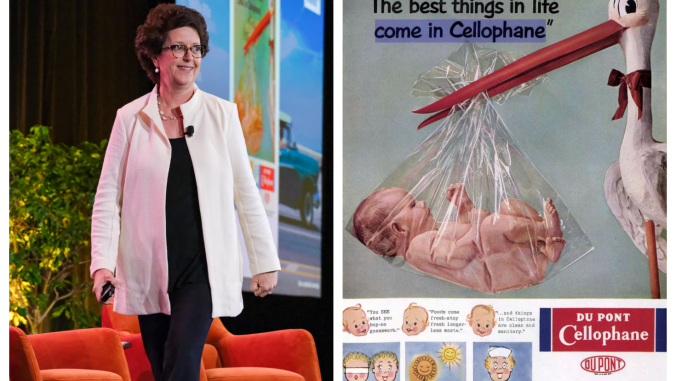Green Marketing: A Two-Fold Lesson in Perception and Reality
Trying to be green is complicated and confusing for most consumers. It's sometimes not very clear even for those of us immersed in the industry. So most people have wrapped their brains around the issue by creating simple truths they can believe in. And those "truths" are based on perceptions, which often can defy reality.

It's going to take me sharing a bit of background to get across the point of this blog entry, but hang in there. The end result is some critical thinking about how to balance creating high-impact marketing/advertising with doing the right thing for the planet.
My firm sent a mailer out recently announcing the release of our Eco Pulse study. The piece features a person's face with a flap that allows the head to pop open and reveal charts, graphs, images, words, etc. The point is that our study reveals what mainstream consumers are thinking about the green movement. It's intended to be attention getting, so we mailed it in a clear envelope that would allow the recipient to see the imagery inside. We went to great pains to create this piece in the most environmentally friendly way available today. Here are the specs:
The issue was two-fold: When the mailer was opened there was a slight odor, which gave this person a message that there was some chemical content/off-gassing. Turns out our printer put the pieces in the envelopes too fast and the coating, which was environmentally friendly, hadn't dried completely, trapping a slight odor inside the envelopes. Perhaps worse than that, though, was that the envelope was plastic. And despite a little card we included with the mailer touting the sustainability of the piece, to this person plastic = bad.
Much like the conundrum of the paper industry I explored in a recent blog post, I think we may have reached a universal truth here about green marketing: Plastic does = bad in the minds of many consumers who are trying to go greener.
Though the vast majority of consumers prioritize their convenience and their comfort over the environment (and thus might have picked up plastic cups and environmentally unfriendly trash bags to use during their Fourth of July celebrations), 26 percent will prioritize the environment first. If that's the desired target of any marketer, no matter how much thought and goodness has been put into a plastic product or marketing piece, that product/message may be instantly discounted simply because it is plastic.
Trying to be green is complicated and confusing for most consumers. Frankly, it's sometimes not very clear for those of us entirely immersed in the industry and trying to educate consumers. So most people have wrapped their brains around the issue by creating simple truths they can believe in, as in recycling = green and plastic = bad.
We gained some insight here that all marketers will do well to heed. Make your message attention getting, but keep in mind that perception is reality. And no matter how environmentally friendly a piece/product actually is the perception of about a quarter of the population is: If it smells bad it is bad, and if it's plastic it's even worse.
Suzanne C. Shelton is founder, president and CEO of Shelton Group, an advertising agency focused exclusively on motivating mainstream consumers to make sustainable choices.
Image CC licensed by Flickr user endolith.
My firm sent a mailer out recently announcing the release of our Eco Pulse study. The piece features a person's face with a flap that allows the head to pop open and reveal charts, graphs, images, words, etc. The point is that our study reveals what mainstream consumers are thinking about the green movement. It's intended to be attention getting, so we mailed it in a clear envelope that would allow the recipient to see the imagery inside. We went to great pains to create this piece in the most environmentally friendly way available today. Here are the specs:
• The paper is made from 100 percent recycled content that's 50 percent post-consumer waste, processed chlorine free and certified Ancient Forest Friendly from a company that is Green Seal certified and uses renewable energy to power their plant.We received an email from a recipient of one of the mailers calling into question whether or not we were "walking our talk."
• The inks used are vegetable based.
• The envelopes are made from a biodegradable poly material that is recyclable, biodegradable and compostable. In fact, they're certified compostable by the ASTM D6400 and DIN EN 13432 standards.
The issue was two-fold: When the mailer was opened there was a slight odor, which gave this person a message that there was some chemical content/off-gassing. Turns out our printer put the pieces in the envelopes too fast and the coating, which was environmentally friendly, hadn't dried completely, trapping a slight odor inside the envelopes. Perhaps worse than that, though, was that the envelope was plastic. And despite a little card we included with the mailer touting the sustainability of the piece, to this person plastic = bad.
Much like the conundrum of the paper industry I explored in a recent blog post, I think we may have reached a universal truth here about green marketing: Plastic does = bad in the minds of many consumers who are trying to go greener.
Though the vast majority of consumers prioritize their convenience and their comfort over the environment (and thus might have picked up plastic cups and environmentally unfriendly trash bags to use during their Fourth of July celebrations), 26 percent will prioritize the environment first. If that's the desired target of any marketer, no matter how much thought and goodness has been put into a plastic product or marketing piece, that product/message may be instantly discounted simply because it is plastic.
Trying to be green is complicated and confusing for most consumers. Frankly, it's sometimes not very clear for those of us entirely immersed in the industry and trying to educate consumers. So most people have wrapped their brains around the issue by creating simple truths they can believe in, as in recycling = green and plastic = bad.
We gained some insight here that all marketers will do well to heed. Make your message attention getting, but keep in mind that perception is reality. And no matter how environmentally friendly a piece/product actually is the perception of about a quarter of the population is: If it smells bad it is bad, and if it's plastic it's even worse.
Suzanne C. Shelton is founder, president and CEO of Shelton Group, an advertising agency focused exclusively on motivating mainstream consumers to make sustainable choices.
Image CC licensed by Flickr user endolith.





